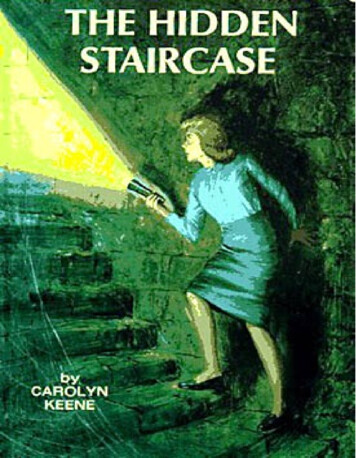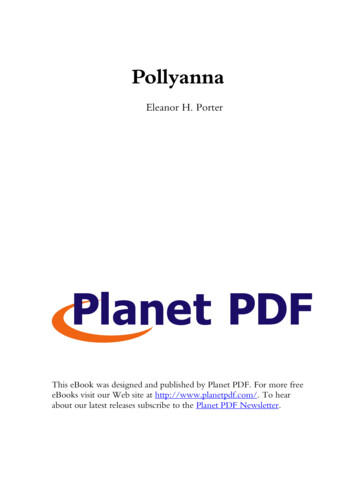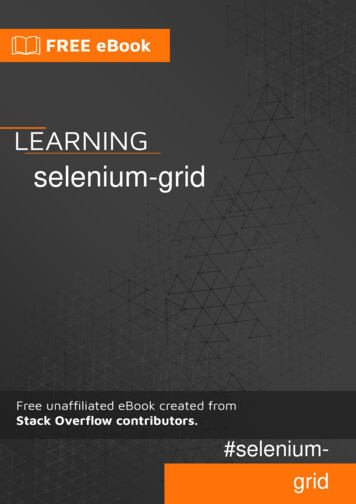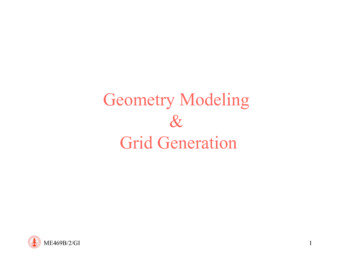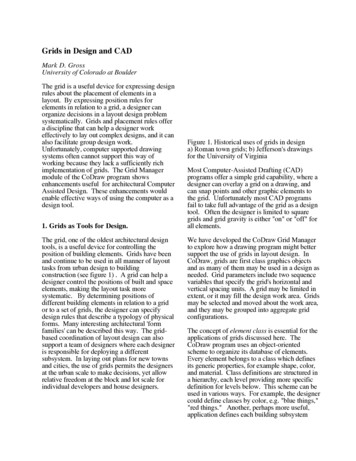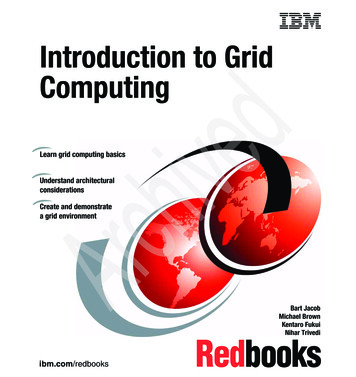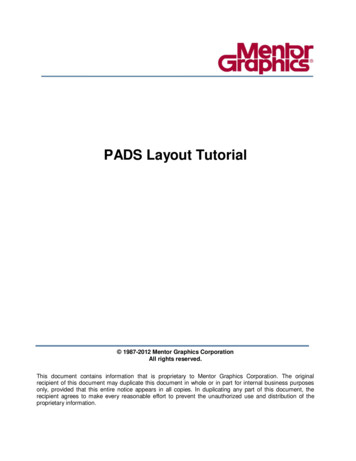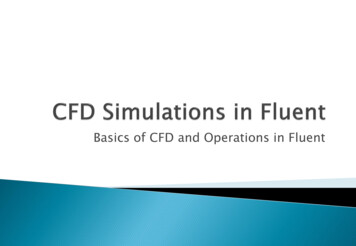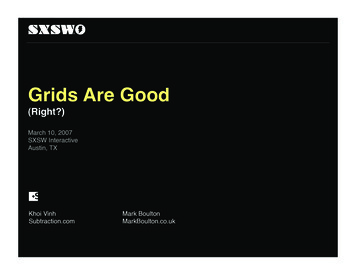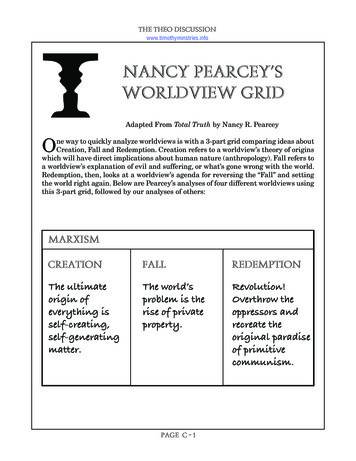
Transcription
THE THEO DISCUSSIONwww.timothyminstries.infoNANCY PEARCEY’SWORLDVIEW GRIDAdapted From Total Truth by Nancy R. PearceyOne way to quickly analyze worldviews is with a 3-part grid comparing ideas aboutCreation, Fall and Redemption. Creation refers to a worldview’s theory of originswhich will have direct implications about human nature (anthropology). Fall refers toa worldview’s explanation of evil and suffering, or what’s gone wrong with the world.Redemption, then, looks at a worldview’s agenda for reversing the “Fall” and settingthe world right again. Below are Pearcey’s analyses of four different worldviews usingthis 3-part grid, followed by our analyses of others:MARXISMCREATIONFALLREDEMPTIONThe ultimateorigin ofeverything isself-creating,self-generatingmatter.The world’sproblem is therise of privateproperty.Revolution!Overthrow theoppressors andrecreate theoriginal paradiseof primitivecommunism.PAGE C -
THE THEO DISCUSSIONwww.timothyminstries.infoROUSSEAU’S PHILOSOPHYCREATIONFALLREDEMPTIONThe true Eden isthe original presocial condition,or the “state ofnature.”The source ofall sufferingand oppressionis society orcivilization. results fromdissolvingsocial ties,leaving peopleindependentfrom oneanother anddependent uponthe state.MARGARET SANGER’S RELIGION OF SEXCREATIONFALLREDEMPTIONSanger was anavid proponentof both biologicaland SocialDarwinism.Social andpersonaldysfunctionsresulted from therise of Christianmorality.Healing andwholenesswill comefrom sexualliberation.PAGE C -
THE THEO DISCUSSIONwww.timothyminstries.infoBUDDHIST & NEW AGE PANTHEISMCREATIONFALLREDEMPTIONThe originof all thingsand ultimatereality is theAbsolute, theOne, a UniversalSpiritualEssence.The source of eviland sufferingis our sense ofindividuality.Our problemswill be solved aswe reunite withthe UniversalSpiritualEssence fromwhich we allcame.THE NEW MILITANT ATHEISMCREATIONFALLREDEMPTIONA selforiginatinguniverse andnatural selectionaccount foreverything.Pre-scientificmysticaland religioussystems broughtIrrationalthinking anddangerousbehavior.The world willbe saved whenall religion isdebunked onceand for all andwe accept thatlife is its ownpurpose.PAGE C -
THE THEO DISCUSSIONwww.timothyminstries.infoISLAMAllah created allthings, animateand inanimate,physical andspiritual.Man is borninnocent andsubsequent sinsdo not corrupthuman nature.Sin resultsfrom externalinfluences.Individualentrance to theGarden by faithand works;redemptionof Earth MPTIONPAGE C -
THE THEO DISCUSSIONwww.timothyminstries.infoSOCIETY’S PERSISTENTATTEMPTS TO MARGINALIZERELIGIOUS TRUTHAdapted From Total Truth by Nancy R. Pearcey, ch. 3.The most pervasive thought pattern of our times is the two-realm view of truth.” The thesisof Pearcey’s book Total Truth is that a legitimate worldview must offer a whole and integraltruth that addresses total reality, not just half of it. Pearcey defends biblical Christianity asindeed addressing all of reality, contrary to Stephen Jay Gould’s theory of Non-OverlappingMagisteria, and the contentions of many others that religion in general and Christianity inparticular only speaks to issues of meaning, or values and not to matters of fact and scientificreality.The irony is that thinkers long for a GUT, a grand unified theory, whether in the fieldof physics or philosophy. Something within us longs for a principle that ties all truth togetherin a unified whole. Biblically speaking, that principle is a person, the Way, the Truth and theLife, Jesus Christ. For that message to reach our neighbors, though, we must clear away thefalse impression that “Christianity isn’t about facts.”Here are some ways that a false dualism of truth (secularization) has been hoisted upon ourculture, sometimes in a witting or unwitting attempt to “keep religion in its place,” and sometimesin a misguided attempt to defend belief in the supernatural and in human dignity:THE ENLIGHTENMENTDESCARTESROMANTICISMMINDReligion and the HumanitiesSpirit, Thought, Emotion, WillENLIGHTENMENTMATTERScience and ReasonA Mechanical, DeterministicMachinePAGE C -
THE THEO DISCUSSIONwww.timothyminstries.infoKANTSOCIAL SCIENTISTSFREEDOMVALUEThe autonomous SelfSocially Constructed MeaningNATUREFACTThe Newtonian World MachinePublicly Verifiable TruthSTEVEN PINKERSECULAR LEAP OF FAITHPOSTMODERN“MYSTICISM”Moral and humane ideals haveno basis in truth, as defined byscientific naturalism.BUT WE AFFIRM THEMANYWAY.THE ETHICS GAMEHumans Have Moral Freedomand DignitySCIENTIFIC NATURALISMTHE SCIENCE GAMEHumans are machines.Humans Are Data-ProcessingMachinesPAGE C -
THE THEO DISCUSSIONwww.timothyminstries.infoMORRIS’S PRINCIPLEOF BELIEF CONSERVATIONIn Philosophy For Dummies, Tom Morris shows that “certainbasic beliefs can be accepted rationally without evidence orproof.” He explains that all rational people engage in a procedureof reasoning that, consciously or unconsciously, operates on theprinciple of inflicting the least damage upon one’s already held framework of beliefs.In Morris’s words it goes like this:For any proposition, P: If1. Taking a certain cognitive stance toward P (for example, believing it,rejecting it, or withholding judgment) would require rejecting or doubting avast number of your current beliefs,2. You have no independent positive reason to reject or doubt all those otherbeliefs, and3. You have no compelling reason to take up that cognitive stance toward P, then it is more rational for you not to take that cognitive stance toward P.Morris continues:In other words, it is most rational, as we modify our beliefs through life and learning, todo the least damage possible to our previous beliefs as we accommodate new discoveriesthat we are making along the way.Your current beliefs are like a raft or boat on which you are floating, sailing across the seasof life. You need to make repairs and additions during your voyage. But it can never berational to destroy the boat totally while out on the open sea, hoping somehow to be able torebuild it from scratch, or else swim without it.This principle of Belief Conservation serves us well in the face of radical skepticism.It is the rational basis for rejecting Bertrand Russell’s Five-Minute Hypothesis, or forthat matter the idea that life was planted on earth by a highly advanced race fromanother galaxy. At the same time, it helps us understand part of the mental processthat creates resistance to the gospel for someone for whom belief in Christ wouldresult in the destruction of an entire, consciously held worldview. IDG Books Worldwide, Inc., Foster City, 1999, p. 73.PAGE C -
THE THEO DISCUSSIONwww.timothyminstries.infoTHE PRECURSIVEFAITH PRINCIPLEOF WILLIAM JAMESEvidentialism demands “proof” for everything that isn’tself-evident or evident to the senses. It proposes thatit is irrational for anyone, anywhere, to believe anythingwithout sufficient evidence. While the insistence that wehave evidence for our beliefs is commendatory, the absolutestance of Evidentialism is self-refuting because there is no sufficient evidence tobelieve its own proposition. There are rational beliefs, like Morris’s Principle of BeliefConservation for example, for which evidence is not even possible. This fact promptedMorris to suggest, for the sake of argument, a modified Evidentialist demand:Modified Evidentialism: It is irrational for anyone, anywhere, at any time, to hold anyevidence receptive belief without sufficient evidence.Enter American psychologist and philosopher, William James (1842–1910). In Morris’swords, James proposed that: there is one kind of evidence receptive belief that it is rational to have in the absenceof sufficient evidence. Sometimes something like the positive state of belief, howevertentative, helps to create a situation in which evidence is more likely to be forthcoming. Insuch circumstances, it is not more rational to wait on evidence before granting a measureof belief, but it is rational to launch out with what James called precursive faith, faith thatetymologically, “Runs ahead of the evidence.”James discovered that championship level endeavor in any sport was typically based onprecursive faith. Champions are regularly challenged to do something they’ve never donebefore . If they just look at the evidence they have concerning their past performances, itwill never be sufficient to prove that they are up to the new challenge and will prevail. ButJames came to realize that what sets champions apart is their ability to engage in precursivefaith and launch out with belief that runs ahead of the available evidence, believing inthemselves up front. James did not believe that precursive faith was always appropriate. He said that“it is rational to believe beyond the available evidence if the option so tobelieve is a genuine option.” And an option is only genuine if it is one that is live(you can bring yourself to believe it), forced (not to choose brings the same results asa negative choice) and momentous (something of importance is at stake). See Philosophy For Dummies, (IDG Books Worldwide, Inc., Foster City, 1999), pp. 76-80. I’m not sure whyJames didn’t use the more standard term precursory.PAGE C -
THE THEO DISCUSSIONwww.timothyminstries.infoTHREE ARENASARENAHISTORYTHE ricalReligionsLogicFINALRESULTSINITIALRESULTSTHE LABEXAMPLESIN THE QUEST FOR ophyPROOFPERSONALSATISFACTIONINTELLIGENTFAITHPAGE C - ASSURANCEBLINDFAITH
THE THEO DISCUSSIONwww.timothyminstries.infoA GREAT EXAMPLE OFA RUBE GOLDBERG MACHINEPAGE C - 10
THE THEO DISCUSSIONwww.timothyminstries.infoHOW WE KNOW THE HORSE IS REALOur Ontological Debt to Descartes Roderick Graciano, 2008Imagine a field in the countryside. Let’s put a horse in the field.Now let’s say you drive by the field and see the horse. As you drive by, a questionenters your mind: “How do I know the horse is real?” You begin to ponder this. “Is itpossible that the horse is a mirage, a trick of sunlight on my retinas? Is the horse adelusion due to my medications? Is the horse an illusion perpetrated upon my mindby some equestrian demon? Or worse, is it an imaginary horse in an imaginary worldall created by my own mind?” I know it’s hard for people with good common sense to put up with suchquestions. We say, “Of course the horse is real! You wouldn’t be driving if you wereon those kinds of medications, and a horse in a country field is a perfectly commonand rational thing.” But philosophy teaches us that we shouldn’t take such things forgranted. If we’re concerned about the ultimate issues of life at all, then we must thinkthrough some of the most fundamental questions, like “How do I know something isreal?” If we’re going to live a thoughtful life, we can’t let our common sense just put areal horse in the field and leave it at that. It really is a valuable exercise to ask if thehorse is real. However, that question leads to the question of whether anything at allis real!This is where the French mathematician and philosopher René Descartes(pronounced dayKART) helps us. We all know at least the last half of his famoussaying, Dubito ergo cogito, cogito ergo sum: “I doubt therefore I think, I think thereforeI am.” Descartes endeavored to doubt everything he could possibly doubt, in order tofind a foundation of certainty. Descartes was a great doubter; he could have doubtedthe reality of our horse in the field with half of his skepticism tied behind his back.But Descartes found that the one thing he could not possibly doubt was his ownexistence, because somebody had to exist to do the doubting! And this is indeed afoundation of certainty from which to explore the reality of the rest of one’s world. Weare indebted to Descartes for this proof of our own existence, I think, therefore I am, Have you ever heard of solipsism? Solipsism is a theory that the self is the only thing that really exists and theillusion of the outside world is only self-perpetrated effects upon the self’s own mind.PAGE C - 11
THE THEO DISCUSSIONwww.timothyminstries.infobecause it allows us to verify the reality of the rest of our world.Here’s how it works: If anything at all exists, it had to have a cause. Philosophersand good scientists say, ex nihilo nihil fit, “out of nothing, nothing comes.” So if anythingat all exists, it had to come out of something, i.e., it had to be caused by something.Thanks to Descartes, we know that something does exist, namely me. Therefore, I hadto have a cause. That presents me with three options:1. I caused or “created” myself.2. I’m self-existent, i.e., I’ve always existed and therefore am the exception to therule of causation.3. I, or at least my first ancestor, was created by something that is self-existent.The first of these options is logically impossible. I can’t have created myself becausethat would require that I had existed before I existed. Option 2 is ruled out by mysense of finiteness and my experience of aging. If I’d always existed, I’d have a muchlonger memory and my body would be crumbling to dust. That leaves only option 3: I,or at least my first ancestor, was created by something self-existent. So, Descartes’ foundation of certainty, I think therefore I am, has led us directlyto the realm of theology. I know I exist, and I know I was brought into existenceby the creative work of a self-existent entity.What can we deduce about this Creator entity? Well, besides the fact that it isself-existent and apparently eternal, it must be super-intelligent. I know I exist andI’m quite intelligent compared to the reasonably smart horse in the field, so whoevercreated me must be super intelligent, and by implication of that intelligence mustalso have personality. Furthermore, for this Creator to go to the trouble of creatingme implies purposefulness; this personal Creator must be doing things on purpose.And two more things: if this Creator is personal, purposeful and super intelligent, itsreasonable to conclude that this same Creator made everything else in the universeand made the universe rationally intelligible.If the universe is rationally intelligible, then we can have assurance that thehorse in the field is indeed real. But philosophically speaking, we owe this assuranceto Descartes and his foundation of certainty, I think therefore I am. The bottom line isthat we cannot put the horse before Descartes. Cf. R. C. Sproul’s discussion of the cosmological argument on p. 126 of The Consequences of Ideas.PAGE C - 12
THE THEO DISCUSSIONwww.timothyminstries.infoBelow is a stunning example of contemporaryontological madness. Are brilliant physicistsphilosophical dunces? Please see the analysisthat follows the excerpt.THE COMPREHENSIBLE COSMOSWhere Do the Laws of Physics Come From?Victor J. StengerPrometheus Books, Amherst, 2006The most incomprehensible thing about the world is that it is comprehensible.— Albert EinsteinWHY IS THERE SOMETHING, RATHER THAN NOTHING? (Pages 170172).Now, you might ask, if the Universe has the global properties of the void, thenwhy is it not a pure void? The answer may be that the void is less stable than auniverse of matter.We often find in physics that highly symmetric systems are not stable as onesof lower symmetry, the states of broken symmetry. That is, the less symmetricstate has a lower energy level, and a system will naturally tend to drop down toits lowest energy state. A pencil balanced on end has rotational symmetry aboutthe vertical axis, but is unstable and loses this symmetry when it topples overto a lower energy state (see fig. 5.5. p. 103).The snowflake is another example that bears reviewing. We are accustomedto seeing snowflakes melt, but that is only because we live in an environmentwhere the temperature is usually above freezing and energy is available inthe environment to destroy the structure. Place a snowflake in a completelyinsulated vacuum, far out in space, and it will, in principle, last indefinitely.4The void is highly symmetric, so we might expect it to drop to a lower energystate of lesser symmetry spontaneously. Calculations based on well-establishedmodels lend support to the notion that highly symmetric states are generally(though not always) unstable.Nobel laureate physicist Frank Wilczek has written the following, which nicelysums up the picture I have been attempting to draw:PAGE C - 13
THE THEO DISCUSSIONwww.timothyminstries.infoModern theories of the interactions among elementary particles suggest that the universe can exist in differentphases that are analogous in a way to the liquid and solid phases of water. In the various phases the propertiesof matter are different; for example, a certain particle might be massless in one phase but massive in another.The laws of physics are more symmetrical in some phases than they are in others, just as liquid water is moresymmetrical than ice, in which the crystal lattice distinguishes certain positions and directions in space.In these models the most symmetrical phase of the universe turns out to be unstable. One can speculatethat the universe began in the most symmetrical state possible and that in such a state no matter existed.The second state had slightly less symmetry, but it was also lower in energy. Eventually a patch of the lesssymmetrical phase appeared and grew rapidly. The energy released by the transition found form in thecreation of particles. This event might be identified with the big bang. The electrical neutrality of the universeof particles would then be guaranteed, because the universe lacking matter had been electrically neutral. Thelack of rotation in the universe could be understood as being among the conditions most favorable for thephase change and the subsequent growth, with all that the growth implied, including the cosmic asymmetrybetween matter and antimatter. The answer to the ancient question “Why is there something rather thannothing?” would then be that “nothing” is unstable.5Does this imply that we have explained how the Universe came from nothing (assumingthat it did)? The meaning of the word nothing is a source of endless debate. How doyou define nothing? What are the characteristics of nothing needed to define it? If ithas any characteristics, any properties, then would it not be something? In his bookWhy There Is Something Rather than Nothing, philosopher Bede Rundle concludes,“[T]here has to be something.”6I have defined the void as what you get when you remove all the matter andenergy. No physical quantities are measurable in the void. The void does not kickback when you kick it. If this void is not “nothing,” then I do not know what is. But ifthe void is unstable, then we have “something” existing as another phase or state ofnothing, the way ice and steam are different phases of water.NOTES 4. In practice, cosmic rays would eventually tear it apart since we could nevercompletely isolate the snowflake from them.5. Frank Wilczek, “The Cosmice [sic] Asymmetry between Matter and Anti- matter.”Scientific American 243. no. 6 (1980): 82-90.6. Bede Rundle, Why There Is Something Rather than Nothing (Oxford: Clarendon,2004), p. ix.PAGE C - 14
THE THEO DISCUSSIONwww.timothyminstries.infoAN ANALYSISOf Stenger’s Explanation Of The Universe’s OriginBy Roderick Graciano, April 2008This two-page explanation, by one-time professor of physics at the University ofHawaii Victor Stenger, of why there is something rather than nothing is oneof the greatest examples of doublespeak I’ve ever seen. Notice first the languageof speculation: may be, the notion, might be, one can speculate, the answer wouldthen be. Notice secondly how this speculation is based not on laws of physics, but oninconsistent possibilities: We often find, symmetric states are generally (though notalways) unstable.Stenger’s biggest problem throughout this short piece of gibberish is his inabilityto decide on a definition of nothing. His example comparing a symmetrical (andunstable) pencil, which has physical forces acting upon it, to the idea of nothingnesswith nothing acting upon it, has absolutely no explanatory value. His example ofa snowflake, which is also symmetrical but can in theory last forever in a vacuum,seems to contradict what Stenger is trying to say in the preceding paragraph. Huh?Then Stenger quotes MIT physics professor Frank Wilczek who appears to sharethe same confusion about the word nothing. Wilczek “speculates” that the universe“began” in a state in which “no matter existed.” That word began is problematic! We’retrying to answer the question of how and why the universe began, not what happenedafter it began. But Wilczek just imagines the universe beginning without explanationin a matter-less state. Well, it’s possible that in its first moment the universe hadno matter, but it had to have something, or else it hadn’t yet begun. I assume thatWilczek envisions a universe without matter but with energy, since he is describingmassless particles (a photon is a massless particle that nevertheless involves energy).Okay fine, but then he is logically wrong to conclude this excerpt by saying that thenothingness of the initial state of the universe “is unstable,” because energy is notnothingness. Wilczek realizes this contradiction and puts “nothing” in quotationmarks. The final sentence of Wilczek’s excerpt should read:The answer to the ancient question “Why is there something rather than nothing?” would then be that [theinitial symmetrical phase of the universe in which only energy existed was] unstable.However, pared down to its real meaning, this final sentence says:The answer to the ancient question “Why is there something rather than nothing?” would then be that [thestate of the original something was] unstable.This of course is utter nonsense. An answer that begins with something does notexplain why that something is there. What Wilczek may be trying to say, and couldsay rationally, is something like this:PAGE C - 15
THE THEO DISCUSSIONwww.timothyminstries.infoThe answer to the question “Why is there a material universe?” is that [the initial phase of the universe inwhich only energy existed was] unstable.But of course this is an entirely different question from the question of why is thereanything at all.Finally, Stenger concludes with further waffling on the meaning of nothing.He questions whether there was ever a time when there was nothing. After all ifnothingness has properties, like symmetry and instability, then it is something ratherthan nothing. Stenger quotes Rundle, “[T]here has to be something.” Now, on the faceof it, both Stenger and Rundle are correct in this paragraph. Both these statementsare true:1. If an entity has properties, it is something rather than nothing.2. There has to be something, in the sense that there was never absolutelynothing.However, Stenger quotes Wilczek to propose a universe without matter as somethingthat has properties, but then concludes his own remarks by assuming a universewithout matter and without energy, i.e., a complete void as having properties! This issurely a misinterpretation of Wilczek — I only hope not a deliberate one. Nevertheless,whether supported by Wilczek or not, for Stenger to propose that the original andutter void, which according to Big Bang theory predates the laws of physics, hasthe property of instability, is to speculate like a madman. Only madmen talk about“another phase or state of nothing”!Rundle’s statement, “There has to be something,” is true, but only metaphysicallytrue. The something that has to be, is not something within the material universe(like Wilczek’s massless phase), but something that precedes the universe. There isnothing inherent in the material universe (matter and energy) that requires it toexist. Big Bang theory states that the universe began, so the universe obviously didn’talways exist of necessity. However, if there were ever absolutely nothing, if there wereever a point at which absolutely nothing existed, nothing would exist now. Ex nihilo,nihil fit: “out of nothing, nothing comes.”So, the real answer to “the ancient question ‘Why is there something ratherthan nothing?’” is Genesis 1.1.PAGE C - 16
THE THEO DISCUSSION www.timothyminstries.info PAGE C - NANCY PEARCEY’S WORLDVIEW GRID Adapted From Total Truth by Nancy R. Pearcey One way to quickly analyze worldviews is with a 3-part grid comparing ideas about Creation, Fall and Redem
